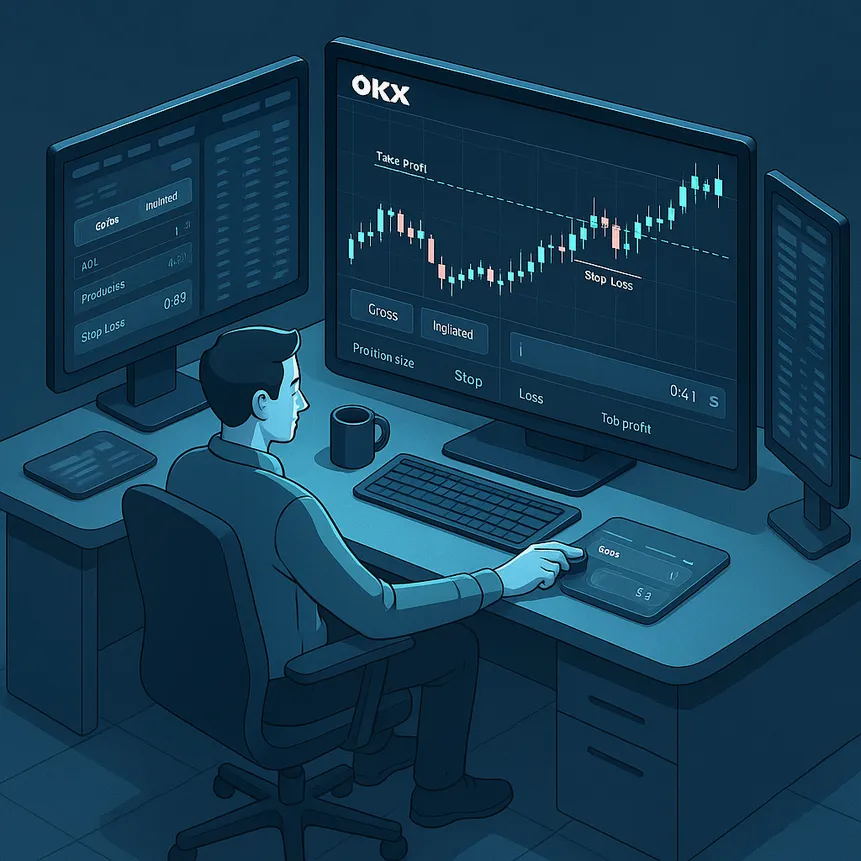Trading with leverage can amplify gains, but it can also magnify risks if you don’t have a plan. If you’ve ever watched a position spiral toward liquidation, you know that sickening feeling when the mark price creeps closer to your liquidation price. The good news: avoiding liquidation on OKX is achievable with a disciplined approach, smart order placement, and a solid understanding of how the platform calculates risk.
Quick win: New to OKX or setting up a fresh account? Join with the referral code CRYPTONEWER and sign up via OKX Join Link to get started with the right tools and fee benefits.
Why liquidations happen on OKX
Before you can avoid liquidation, you must understand it:
- Mark price vs. last price: OKX uses a fair “mark price” derived from an index and other inputs to reduce unnecessary wicks and manipulation. Liquidations trigger off the mark price, not the last traded price.
- Maintenance margin (MM): Each position must maintain a minimum amount of equity relative to size and risk tier. If your account equity falls below maintenance margin, liquidation begins.
- Risk limits and tiers: Larger positions have stricter maintenance margin rates and lower max leverage. As your notional size grows, move up tiers and keep an eye on your effective maintenance margin rate.
- ADL (auto-deleveraging): If the insurance fund can’t absorb losses during extreme moves, profitable traders may be auto-deleveraged according to the ADL queue. Minimize your ADL exposure by controlling leverage and position concentration.
The key idea: Liquidation is rarely about “bad luck” and mostly about insufficient margin, oversized positions, unchecked leverage, and missing exit plans.
Choosing the right margin mode on OKX
OKX offers multiple account and margin modes. Picking the right one for your strategy materially affects liquidation risk.
-
Isolated Margin
- Each position has dedicated margin. If the position goes south, the loss is contained to that position.
- Ideal for short-term setups or when testing a new strategy.
- Pro move: Keep risky trades isolated. If it fails, the rest of your account is safe.
-
Cross Margin
- All positions share margin from your account equity. This can reduce liquidation risk for a single trade because your entire balance buffers it.
- The risk: One bad trade can drain margin needed by others.
- Use when your positions hedge each other or when you keep a tight risk cap and active stops.
-
Unified Account and Portfolio Margin
- Unified Account lets you trade spot, futures, and options from one pool of collateral.
- Portfolio Margin evaluates risk across the entire portfolio; hedged positions can enjoy lower margin requirements.
- If you run options hedges or basis trades that reduce net risk, Portfolio Margin can significantly lower your chance of liquidation by recognizing offsetting positions.
Tip: If you’re new or still building consistency, Isolated Margin is more forgiving. Graduate to Cross Margin and Portfolio Margin as you master risk offsetting.
Sizing positions and choosing leverage responsibly
- Use small but meaningful leverage: For many traders, 2x–5x is a sweet spot. Above that, small price moves can trigger cascading margin calls.
- Back into position size: Start from your stop-loss distance. Example: If your stop is 2% away and you’re comfortable risking 1% of your account per trade, set the position size so a 2% move equals 1% account loss.
- Ladder entries rather than “all-in”: Break entries into 2–5 tranches. You’ll smooth out slippage and reduce the chance of catching a top or bottom wick.
- Respect risk tiers: Know the notional thresholds where your maintenance margin rate increases. If you’re near a tier boundary, consider trimming size to stay in a lower-risk tier.
A simple mental model: If a 1% adverse move makes you sweat, your position is too big.
Order types that protect you
OKX provides several order types that can dramatically cut liquidation risk when used correctly:
-
Stop-Loss Orders
- Set a stop the moment you open a position. Move it only to reduce risk, not to widen it.
-
Take-Profit (TP) and Scale-Outs
- Place multiple TP orders to lock gains and shrink size as the market moves in your favor.
-
Reduce-Only
- Prevents your closing orders from accidentally increasing exposure. Essential when managing partial exits or hedges.
-
Trailing Stops
- Automatically tightens risk on trending moves while giving the trade room to breathe.
-
Trigger Orders with Price Protection
- Trigger off the mark price to avoid random last-trade spikes.
-
Advanced Execution (TWAP, Iceberg)
- Improve fills on large orders without signaling size to the market.
Put it together: Define your invalidation level first, set your stop, then layer take-profits. Don’t improvise mid-trade.
Collateral hygiene and margin quality
- Favor stable collateral for margin: Using highly volatile tokens as collateral can shrink your equity at the worst time. Stablecoins typically reduce collateral volatility risk.
- Avoid over-collateralizing one volatile asset: Diversify collateral where possible, but keep it highly liquid.
- Understand haircuts: Different assets may be discounted when used as collateral. Check haircuts so you don’t overestimate buying power.
- Keep a buffer: Maintain extra margin so sudden volatility or funding payments don’t push you into forced deleveraging.
Pro tip: A 10–30% free margin buffer can absorb funding, slippage, and small gaps.
Funding, fees, and the hidden cost of carry
-
Funding Rate
- Perpetual swaps pay/receive funding periodically. If you are on the paying side for days, it quietly eats your margin.
- Action: Check funding forecasts. If it’s persistently expensive, consider reducing size, hedging, or switching instruments.
-
Maker/Taker Fees
- Tight risk management includes fee awareness. Aggressive taker entries/exits add up and can reduce usable equity.
-
Interest and Borrowing
- If you borrow assets under Margin trading, monitor interest. Long holds may erode your safety cushion.
Reading the ADL indicator and insurance fund context
-
ADL Bars
- The ADL indicator shows your likelihood of being auto-deleveraged. High ADL exposure means market stress or excessive leverage.
- Response: Reduce leverage, realize partial profits, or hedge to lower ADL risk.
-
Insurance Fund
- In extreme moves, if the insurance fund is stressed, ADL events become more likely. The best defense is smaller, hedged, and well-stopped positions.
Hedging strategies that actually reduce liquidation risk
-
Options Protective Put (for long futures/spot)
- Long BTC perpetual? Buy an out-of-the-money put. If price dumps, the put’s value offsets losses and can prevent liquidation.
- Tip: Time the put around events; if volatility is high, consider smaller size or closer strike to get meaningful protection.
-
Covered Call (against spot)
- If you hold spot and sell a call, the premiums can offset drawdowns. Use with caution; upside is capped beyond the strike.
-
Futures-Spot Basis Hedge
- Long spot + short perpetual can lock in basis or reduce directional exposure. Less direction equals lower liquidation risk.
-
Pair Trades
- Long a strong asset, short a weaker correlated asset. The net exposure is smaller than a directional bet, lowering margin stress.
Hedge wisdom: A smaller, hedged position usually outlives a large, naked one.
Event risk and volatility playbook
- Calendar discipline: Track major economic data, FOMC days, and large token unlocks. Volatility spikes liquidate poorly protected positions.
- Pre-event actions:
- Reduce leverage or size.
- Convert cross to isolated on riskier legs.
- Tighten stops or add temporary options hedges.
- Post-event actions:
- Wait for spreads and funding to normalize before re-leveraging.
Automation that saves accounts
-
Price Alerts
- Set alerts at key support/resistance and near liquidation threshold. If you’re away, alerts buy you reaction time.
-
Conditional Orders and OCO
- One-cancels-the-other helps you avoid manual errors. If TP hits, the stop cancels automatically.
-
API and Bots
- Use bots with strict max-drawdown, reduce-only exits, and global kill-switches. Backtest settings with conservative assumptions and out-of-sample data.
-
Grid with Stop
- If you run grid strategies, always include a hard stop or equity stop. No strategy is “set and forget.”
End-to-end example: turning a risky long into a resilient trade
Scenario: You want to long ETH perpetual at 5x.
1) Choose Isolated Margin to contain risk.
2) Determine risk per trade at 1% of account. With a 3% stop distance, size position so a full stop equals 1% loss.
3) Place initial entry with two laddered limits and a protective stop-loss at the invalidation level.
4) Set three take-profit targets to scale out 30/30/40% as price advances.
5) Check funding. If paying high funding, plan to reduce size if the move stalls.
6) Add an out-of-the-money put if a major news event is looming. This reduces liquidation risk if the market gaps down.
7) Monitor ADL bars. If they rise, trim size or lock in profit to reduce ADL exposure.
8) If price moves in your favor, trail the stop under higher lows using reduce-only orders.
Result: Even if ETH dips aggressively, you’re stopped before liquidation. If volatility explodes, the put can offset losses, and your position size keeps your maintenance margin safe.
Common mistakes that lead to liquidation (and quick fixes)
-
Mistake: Adding to losers to “improve average.”
- Fix: Only add when your thesis is intact and technicals confirm. Otherwise, reduce risk.
-
Mistake: No stop-loss because “I’ll manage it manually.”
- Fix: Pre-place stops and use reduce-only exits.
-
Mistake: Using volatile tokens as the sole collateral.
- Fix: Favor stablecoins and maintain a margin buffer.
-
Mistake: Ignoring funding and fees.
- Fix: Factor carry costs into your holding period and sizing.
-
Mistake: Oversized cross margin bets.
- Fix: Move risky legs to isolated or hedge them.
-
Mistake: Trading through major events with high leverage.
- Fix: De-lever or hedge ahead of time; wait for post-event stabilization.
Fast checklist you can reuse before every trade
- What margin mode am I using (isolated or cross)?
- Is my position size aligned with my stop distance and account risk cap?
- Are stop-loss and take-profit orders placed, reduce-only enabled where needed?
- Do I have a margin buffer for funding and volatility?
- Have I checked risk tiers, maintenance margin rate, and ADL indicator?
- Is there a foreseeable event or unlock that could spike volatility?
- Would a small options hedge lower tail risk?
Get started safely with OKX
Want a fresh account setup aligned with risk-first trading? Join with code CRYPTONEWER via OKX Join Link. Configure Isolated Margin for your riskier strategies, bookmark your liquidation preview panel, and practice placing stops and TPs on a small position before you scale.
Remember: Survival is a strategy. On OKX, the traders who avoid liquidation are the ones who plan their exits, size prudently, and let hedges do their quiet work.





